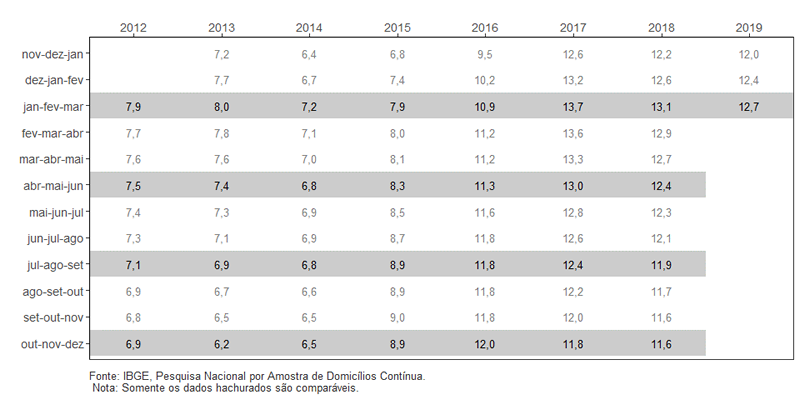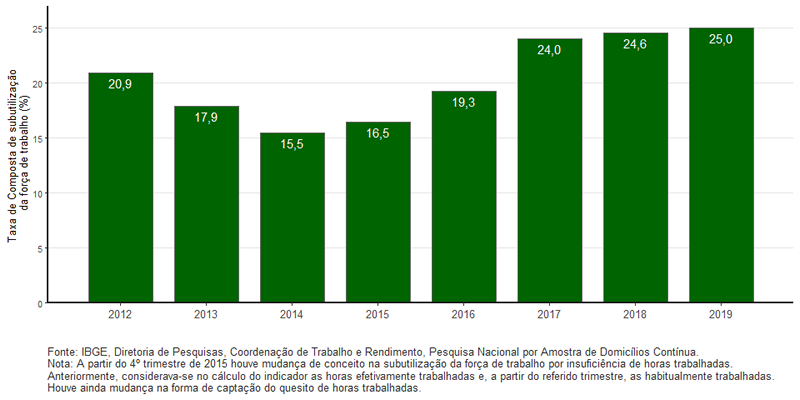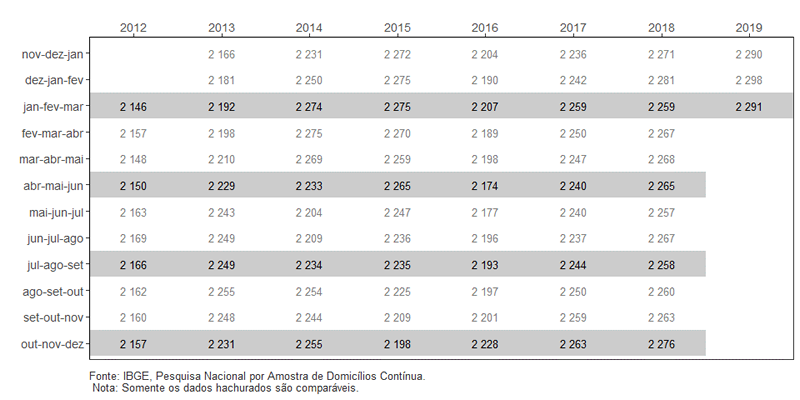Continuous PNAD: unemployment rate is 12.7% and underutilization rate is 25.0% in quarter ended in March 2019
April 30, 2019 09h00 AM | Last Updated: May 02, 2019 01h46 PM
The unemployment rate (12.7%) in the quarter ended in March 2019 increased 1.1 percentage points (pp) in relation to the quarter of October to December 2018 (11.6%) and fell -0.4 in relation to the moving quarter of January to March 2018 (13.1%).
| Indicator / Period | Jan-Feb-Mar 2019 | Oct-Nov-Dez 2018 | Jan-Feb-Mar 2018 |
|---|---|---|---|
| Unemployment rate | 12.7% | 11.6% | 13.1% |
| Labor underutilization rate | 25.0% | 23.8% | 24.6% |
| Usual real earnings | R$2,291 | R$2,276 | R$2,259 |
| Change of the real usual earnings in relation to: | 0,7% (stability) | 1.4% (stability) | |
The unemployed population (13.4 million) increased 10.2% (1.2 million more persons) over the previous quarter from October to December 2018 (12.2 million). No statistically-significant change was registered in relation to the same quarter of 2018 (13.6 million).
The employed population (91.9 million) decreased -0.9% (873 thousand less persons) compared with the October-December 2018 quarter and increased 1.8% (1.6 million more persons) in relation to the same quarter in 2018.
The population out of the workforce (65.3 million) stood stable over the quarter from October to December 2018 (65.1 million) and increases 1.0% (649 thousand more persons) against the same quarter of 2018 (64.6 million).
The labor underutilization rate (25.0%) in the quarter ended in March 2019 is a record in the time series started in 2012, with a high of 1.2 pp in relation to the previous quarter (23.8%). Compared with the same moving quarter a year ago (24.6%), the change was not statistically relevant.
The underutilized population (28.3 million)is a record in the series in both comparisons: up 5.6% (1.5 million more persons) in relation to the previous quarter and of 3.0% (819 thousand more persons) in relation to the same quarter of 2018.
The number of discouraged persons (4.8 million) increased in both comparisons: up 3.9% (180 thousand persons) in relation to the quarter from October to December 2018 and up 5.6% (256 thousand persons in relation to the same quarter of 2018. The percentage of discouraged persons (4.4%) kept the series' record and had a significant change in both comparisons: 0.1 pp in relation to the previous quarter (4.3%) and up 0.2 pp against the same quarter of 2018 (4.2%).
The number of persons employed in the private sector with a formal contract (excluding domestic workers) was 32.9 million, staying stable in both comparisons. Conversely, the number of persons employed without a formal contract (11.1 million) fell (-3.2%) compared with the previous quarter (365 thousand less persons) and rose 4.4% (466 thousand more persons) compared with the same quarter in 2018.
The category of self-employed workers (23.8 million) remained stable in the comparison with the previous quarter and increased 3.8% in relation to the same quarter last year (879 thousand more persons).
The average usual real earnings (R$2,179) remained stable in both comparisons. The average usual real wage bill (R$205.3 billion) held steady against the previous quarter and grew 3.3% over the same quarter of 2018.
Table 1 - Unemployment Rate - Brazil - 2012/2019

The unemployment rate was 12.7% in the moving quarter ended in March 2019 and increased 1.1 pp in relation to the moving quarter from October to December 2018 (11.6%). In relation to the moving quarter from January to March 2018 (13.1%), there was decrease of -0.4 pp.
Approximately 13.4 million persons were unemployed in Brazil in the quarter between January and March 2019. This contingent rose 10.2% (1.2 million more persons) against the quarter from October to December 2018 (12.2 million) and did not post a statistically significant change in relation to the same quarter of 2018 (13.6 million unemployed persons).
The compound rate of labor underutilization - percentage of unemployed persons or time-related underemployed persons or persons in the potential workforce in relation to the extended workforce - was 25.0% in the quarter from January to March 2019, representing a high of 1.2 pp over the quarter from October to December 2018 (23.8%). It remained stable when compared with the same moving quarter a year ago (24.6%).
Compound rate of labor underutilization – quarters from January to March – 2012/2019 Brazil (%)

In the quarter from January to March 2019, 28.3 million persons were unemployed in Brazil. This contingent rose 5.6% (1.5 million more persons) against the quarter from October to December 2018, when underutilization was estimated at 26.8 million persons. Compared with the same quarter of 2018, when there were 27.5 million underutilized persons, there was a high of 3.0% (819 thousand more persons).
The contingent of time-related underemployed persons was estimated at nearly 6.8 million persons in the quarter from January to March 2019. This population remained stable in relation to the previous quarter (October to December 2018) and had a high of 10.2% against the same quarter in 2018.
The potential workforce was estimated at 8.169 million persons in the quarter from January to March 2019 and hit a record in the series. The number of discouraged persons increased in both comparisons: up 4.7% (364 thousand persons) in relation to the quarter from October to December 2018 and up 5.7% (443 thousand persons) in relation to the same quarter of 2018.
The potential workforce comprises persons aged 14 and over, who were neither employed nor unemployed in the week of reference, but were potentially available to become part of the workforce.
The contingent out of the workforce in the quarter from January to March 2019 was of 65.3 million persons, with stability in relation to the quarter from October to December 2018 and a high of 1.0% (649 thousand more persons) over the same quarter of 2018.
The discouraged population was of 4.8 million in the quarter from January to March 2019 and grew in both comparisons: 3.9% compared with the previous quarter (180 thousand more persons) and 5.6% (256 thousand more persons) in relation to the same quarter of 2018.
The percentage of discouraged persons over persons in the workforce or the discouraged (4.4%) kept the series' record of the time series and had a significant change in both comparisons: 0.1 pp in relation to the previous quarter (4.3%) and up 0.2 pp against the same quarter of 2018 (4.2%).
The workforce – employed and unemployed persons – was estimated at 105.3 million persons. There were highs in both comparisons: 0.3% (361 thousand more persons) over the previous quarter and 1.3% (1.3% million persons) in relation to the same quarter of 2018.
The number of employed persons reached 91.9 million persons in the quarter from January to March 2019, with a reduction of -0.9% (873 thousand fewer persons) in relation to the previous quarter and a high of 1.8% (1.591 million more persons) in relation to the same quarter in 2018.
The employment-population ratio – percentage of employed persons in the population at working age – was estimated at 53.9% in the quarter from January to March 2019, with reduction of -0.7 percentage points over the October-December 2018 quarter (54.5%) and positive change (0.3 percentage points) in relation to the same quarter in 2018 (53.6%).
The number of persons employed in the private sector with a formal contract (excluding domestic workers) was 32.9 million persons, staying stable in both comparisons.
The category of workers in the private sector without a formal contract (11.1 million persons) had a reduction of -3.2% (365 thousand less persons) in relation to the previous quarter. It increased 4.4% (466 thousand more persons) over the same quarter in 2018.
The category of the self-employed workers, made of 23.8 million persons, recorded stability in the comparison with the previous quarter and had a high of 3.8% (more than 879 thousand persons) in relation to the same period of 2018.
In the period from January to March 2019, the number of employers (4.4 million persons) remained stable in both comparisons.
The number of domestic workers reached 6.1 million persons, with reduction of -2.4% in relation to the previous quarter and remained stable over the same quarter of 2018.
Estimated at 11.4 million persons, the group of persons employed in the public sector (including statutory servants and military) recorded a drop of -2.0% over the previous quarter and kept stable in relation to the same quarter of 2018.
The average usual real earnings (R$2,291) remained stable in both comparisons.
The average usual real wage bill (R$205.3 billion) held steady against the previous quarter and grew 3.3% over the same quarter of 2018.
Average monthly usual real earnings from all jobs of employed persons - Brazil - 2012/2019 - (R$)


